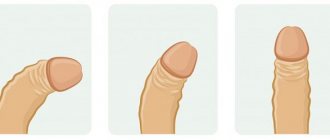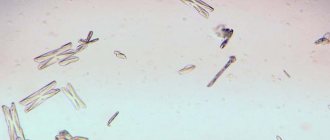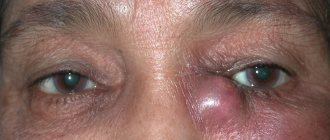A fissure is a linear break in the skin.
It is formed as a result:
- decreased skin elasticity;
- excessive mechanical impact on it.
Sometimes both factors are combined.
With irritants of normal strength, the skin does not tear and cracks do not appear.
But if it is inflamed, an infiltrate forms.
It reduces elasticity and the skin becomes more prone to cracking.
Cracks on the penis in men can appear for a huge number of reasons.
Most often, the etiological factor is an infectious process, trauma or dermatological diseases.
Cracks on the penis due to sexually transmitted infections
In most cases, sexually transmitted diseases do not initially affect the skin of the penis.
They cause inflammatory processes in the urethra.
But as inflammation progresses, discharge appears from the urethra.
They can be plentiful.
The discharge contains bacteria or other pathogenic microorganisms.
They cause inflammatory damage to the head.
Cracks in the foreskin of the penis may also form. This symptom does not appear immediately.
Initially, only red spots appear. Itching, plaque, and unpleasant odor may appear.
But if there is no treatment or it is incorrect, pathological changes progress.
Abscesses, erosions, fissures of the penis or ulcerations occur.
They can be caused by the following pathogens:
- chlamydia;
- gonococci;
- candida;
- herpes.
Very rarely, other pathologies lead to inflammation and cracking of the skin on the penis.
It could be gardnerellosis, trichomoniasis.
Primary syphiloma sometimes looks like a fissure.
Usually, after infection with syphilis, erosion appears on the penis.
Less commonly, it is an ulcer – a deeper lesion.
In rare cases, atypical chancre occurs.
One of its forms is a longitudinal crack in the mucous membrane.
This type of chancre is called slit-shaped.
It can be distinguished by its dense base, which has a cartilaginous density.
Although primary syphiloma is usually painless, in this case pain is possible.
Sometimes cracks in the skin of the penis bleed, usually after mechanical irritation.
It may be covered with a gray coating on top.
Sometimes the crack is covered with a crust.
Causes
• Masturbation
As a result of friction during masturbation, the integrity of the skin is compromised due to lack of lubrication. An infection gets into the wounds, which provokes an inflammatory process. In this case, redness, swelling, itching and burning are visualized.
The head becomes hypersensitive; during sexual contact, early ejaculation and dyspareunia are possible. If you ignore the problem, in the future there is a risk of receptor death and a decrease in sensations during frictions. Getting used to excessive stimulation during masturbation and the consequences of fissures can lead to erectile dysfunction, more often to relative anejaculation. In this case, the man will not be able to achieve orgasm during sexual intercourse, which may affect the relationship in the couple.
• Poor hygiene practices
Neglect of hygiene, lack of habit or opportunity to take a daily shower contributes to the accumulation of urine and smegma in the folds of the skin. Not only beneficial, but also opportunistic and pathogenic microorganisms live on the skin and mucous membrane. Under favorable conditions (warm, damp, nutritious environment), inflammation of the foreskin or glans penis occurs frequently.
• Tight clothes
The wrong size of underwear (especially synthetic ones), or preference for clothes that are too tight will lead to impaired blood circulation in the pelvic organs. As a result of tissue ischemia, at the slightest trauma, cracks appear on the head or skin of the penis.
• Allergic reaction
Manifestations of allergies can appear anywhere, including in the intimate area. Provoking factors include the use of aggressive detergents and abuse of disinfectant solutions after unprotected sex: Miramistin, Chlorhexidine, etc. These substances kill all flora, disrupt the functioning of the glands, which is manifested by dry skin. Sometimes cracks in the penis appear as a result of an allergy to latex or to local contraceptives, which the partner uses to protect against unwanted pregnancy.
• Concomitant endocrinological diseases
Diabetes mellitus disrupts metabolic processes in the body; with high levels of glucose in the blood, urine changes its biochemical properties. As a result of the irritating effect, redness, cracks, and itching appear on the skin of the penis and on the head. The immune system also suffers, which makes it easier for microbial flora to multiply. Local treatment brings temporary relief. Frequent formation of cracks and wounds on the penis is the cause of cicatricial phimosis.
• Urological diseases
There are a number of urological diseases in which the appearance of cracks and wounds on the penis is part of the clinical picture:
• phimosis (narrow foreskin); • short bridle; • paraphimosis; • balanoposthitis; • urogenital candidiasis.
Phimosis and paraphimosis require surgical treatment, without which the pathology will progress and sexual life will remain a memory.
Constantly tearing frenulum during sex and cracks with inflammation significantly worsen a man’s quality of life. Surgery for this pathology solves the problem 100%.
Predisposing factors for the appearance of balanoposthitis are STIs, diabetes mellitus, thrush, trauma, etc.
Sometimes it is not possible to determine the cause without conducting a study; it is necessary to take tests for STDs and blood sugar. If you independently treat yourself with a broad-spectrum antibacterial drug, without taking tests, adverse consequences are possible:
• reinfection (re-infection) from a sick partner; • undiagnosed diabetes mellitus with the prospect of complications; • the risk of “not guessing” the sensitivity of the pathogen to the antibiotic, unpleasant symptoms will decrease or disappear, and the man will become a carrier of a sexually transmitted infection, or the disease will take a chronic form. • the likelihood of complications: prostatitis, urethritis, vesiculitis, orchitis, etc.
Candidiasis (thrush) in men, if not treated in a timely manner, also contributes to the formation of cracks and erosions on the glans penis. During the examination, the doctor can suggest a diagnosis, but you need to be tested for major sexually transmitted infections. Urogenital candidiasis can be accompanied by any sexually transmitted disease. Cracks on the head of the penis due to thrush are covered with a specific white coating with a cheesy odor.
• Dermatological diseases
Psoriasis, dermatitis, eczema are often complicated by the appearance of cracks on the penis, dry skin (or weeping), burning, itching.
The process rarely occurs in isolation; as a rule, the patient is aware of the diagnosis. For many skin diseases, periods of remission, when there are no clinical manifestations, and exacerbation, with pronounced symptoms, are typical.
Cracks on the penis due to rubbing
Mechanical dermatitis is the name of aseptic inflammation caused by physical damage to the skin.
The inflammatory response occurs without the participation of bacteria or other microorganisms.
With it, cellular infiltration of the skin always occurs.
Immune cells accumulate in it.
The skin thickens and becomes less elastic.
Therefore, penile cracks can easily appear on it.
Chafing is always caused by prolonged, albeit mild, irritation.
It is strong enough to damage the upper layers of the skin and cause inflammation.
But at the same time, it is weak enough that the patient does not feel friction for a long time or does not pay attention to it.
Friction itself does not cause pain.
But over time, an inflammatory reaction begins.
The penis swells in the place that is exposed to physical contact with a source of friction for a long time.
The skin becomes sensitive.
Pain appears.
If a man takes action, the friction stops and a crack on the head of the penis does not appear.
If exposure continues, inflammation may worsen.
Cracks appear.
They can be caused either by mechanical trauma to the penis due to continued friction, or by the addition of bacterial flora.
How can you rub the skin to such an extent that cracks appear on the penis?
Usually the cause is underwear or a zipper on the trousers.
In some cases it is an item in your pocket.
Whatever the cause, it can usually be eliminated by stopping trauma to the penis.
Scab on the head of the penis
There may be an itchy sensation of the skin in the groin.
This is a sign of the appearance of a scab on the penis.
If you find a scab on the head of your penis, you need to visit a specialist as soon as possible.
It is important to undergo the necessary laboratory tests.
This will allow you to make a correct diagnosis and determine the disease that caused the appearance of crusts on the penis.
There are a number of reasons that influence the formation of scabs in the intimate area.
Most often these are infections, allergies or systemic diseases.
Scabs due to herpes
Herpes is one of the common viral diseases.
This infection occurs quite often in males.
A characteristic sign of herpes will be the appearance of small blisters.
As a rule, the elements of the rash contain liquid inside.
The rash is accompanied by itching and pain.
If the vesicles are damaged during the acute period, a man is able to infect his sexual partner.
Herpes infection is transmitted not only through sexual contact, but also through the use of personal hygiene items.
It takes about a week from the moment of infection to the appearance of visible signs.
Scabs on the penis due to allergies
When using low-quality underwear or intimate hygiene products, allergic reactions may occur.
Allergens accumulate and inflammation develops.
The reaction leads to discomfort and the formation of scabs on the penis.
Allergies are accompanied by the following symptoms:
- 1.Swelling
- 2.Hyperemia of the mucous membranes
- 3. Formation of rashes and blisters
- 4. Peeling of the skin
These signs disappear when the allergen is eliminated.
Scabs with streptoderma
The cause of the pathological process is streptococcus, the pathogen provokes an infectious process.
As a result, rashes form on the skin; they can be round in shape and contain pus.
During the process of damage, the rashes become covered with crusts.
Streptoderma is characterized by the appearance of pink spots.
They will have a flaky surface.
There may be enlargement of the lymph nodes.
Note! If symptoms of streptoderma appear, you should visit a specialist as soon as possible.
Scabies for scabies
The cause of the appearance of crusts is scabies mites.
It penetrates under the skin, causing itching.
In men, pinpoint rashes begin to appear in the groin.
The site of entry of the parasite can be detected.
Strong itching sensations are observed, mainly the head and foreskin of the genital organ are affected.
Scabbing with psoriasis
Psoriasis is characterized by the appearance of rashes.
The disease has a slow course.
In the affected areas, you can find dry patches of skin that itch.
Other areas of the body may be affected: often elbows, knees, skin folds.
For psoriasis, scabs are treated.
Important! Untimely treatment leads to the spread of the pathological process.
Scabs with syphilis
Syphilis is a dangerous sexually transmitted disease.
After infection with Treponema pallidum, the first signs appear after one or two months.
For primary syphilis, the appearance of ulcers on the penis is noticeable.
When they are damaged, a scab forms.
After some time, the ulcers spontaneously disappear, after which secondary syphilis begins to develop.
Rashes form all over the body; they are bright red in color and irregular in shape.
Scabs due to injury or chafing
Can be detected with mechanical damage to the skin.
A common cause of their appearance is the pinching of the penis by lightning.
It is possible for the penis to rub during sexual intercourse or wearing tight synthetic underwear.
Scabs on the penis due to skin cancer
One of the causes of cancer is the human papilloma virus and age-related changes.
Signs of cancer include the appearance of rashes or ulcers with thickening of the skin.
Liquid accumulates under the foreskin and has an unpleasant odor.
Scabs on the penis due to folliculitis
Formed as a result of damage to the hair follicle.
Develops due to non-compliance with intimate hygiene rules.
The cause may be allergies, diabetes or chafing.
Cracks on the penis due to allergies
Allergic inflammation of the penis occurs quite often in people prone to allergies.
With a high intensity of the process, it can lead to the appearance of cracks on the head of the penis or any other part of it.
If the penis is inflamed, but there are no skin reactions in other parts of the body, most likely the allergen is in direct contact with the male genital organ.
The reaction develops according to the type of contact dermatitis.
This is a delayed T-cell reaction.
Sensitization to an allergen can occur over a long period of time.
This process often stretches over weeks, months and even years.
Therefore, when questioned, a man often denies that a substance named by a doctor could cause an allergy.
He explains this by the fact that over a long period of use there were no allergic reactions.
But in fact, it turns out that upon repeated contact, allergic reactions occur again or get worse.
If sensitization has already occurred, then each time the skin of the penis comes into contact with an allergen will be accompanied by skin reactions.
With severe inflammation, cracks in the penis can appear deep and painful.
The cause is the same inflammatory infiltration, which reduces the elasticity of the skin.
Often the patient does not understand what caused the pathology.
He continues to use the substance to which he is allergic.
As a result, symptoms worsen and the risk of cracks increases.
An allergy may be to:
- lubricant;
- skin care creams;
- spermicides;
- medications used;
- condom;
- additives included in the condom (menthol, glycerin, flavoring, etc.).
Sometimes manifestations occur after sexual intercourse.
This may mean that the allergen is the product used by the patient's spouse.
In any case, it must be identified and excluded.
After this, inflammatory processes will decrease.
The cracks will heal and, in the absence of further allergic reactions, will not appear again.
Symptoms
As a rule, peeling skin on the penis is not the only sign of problems in the body. The symptom is often accompanied by:
- irritation and itching,
- an increase in local and general temperature,
- redness of the skin,
- pathological discharge from the urethra,
- the appearance of wounds or skin blisters,
- the appearance of cracks and excessive dryness,
- pain in the genital area,
- swelling of the inguinal lymph nodes.
If a man experiences the above symptoms or the skin on the penis peels off for a long time, he should definitely consult a doctor. Only a doctor can make a correct diagnosis after a comprehensive diagnosis.
Cracks on the penis due to streptoderma
Streptoderma is a purulent inflammatory process of the skin.
It occurs as a result of infection with streptococci.
They are part of the normal skin flora.
Inflammatory processes are caused only in the presence of predisposing factors.
These could be:
- poor immunity;
- skin damage;
- HIV;
- diabetes;
- poor hygiene.
Usually, superficial bacterial infection of the skin of the penis does not cause cracks.
But if a man does not take any measures (does not undergo treatment, does not change hygiene habits, etc.), then the infection penetrates deeper.
A strong inflammatory reaction develops.
Ulcers appear.
The skin swells greatly and may crack.
Cracks with streptoderma are very painful.
Cracks on the penis due to herpes
Herpes infection is a sexually transmitted disease.
It rarely manifests itself as cracks on the penis, but sometimes it happens.
Usually, small blisters appear as a result of herpes. They are filled with clear liquid.
In their place, crusts remain, which fall off, leaving pigmentation.
But with severe herpes, the skin can become very inflamed.
It turns red and there is a sharp pain or burning sensation. Severe swelling is observed.
Cracks appear. They can occur together with other morphological elements of the skin.
In other cases, there are no vesicles or papules. Only erosion and cracks are formed. They are very painful.
The risk of severe herpes increases with:
- primary infection (relapses are usually easier);
- HIV (all infections are severe);
- diabetes mellitus;
- concomitant infections, including sexually transmitted infections.
Prevention of crack formation
- 1Daily hygienic care of the skin of the penis (shower/bath).
- 2Annual screening for sexually transmitted infections, including viral and candidiasis, screening for HPV. Annual medical examination by a dermatovenerologist and urologist.
- 3Prevention of STIs.
- 4Use for washing soft, non-concentrated, hypoallergenic soap solutions (Mustela, Avene, Topicrem, etc.).
- 5If there are signs of balanoposthitis, maximum limitation of physical influences on the head area (avoidance of sexual intercourse, masturbation, erection).
- 6If you have an unfavorable allergy history, follow a diet, hypoallergenic lifestyle, and correct allergy manifestations.
- 7If the elasticity and strength of the skin of the head and foreskin is impaired, its thinning, dryness - diet correction, consultation with a dermatologist. It is important to remember that the use of conventional cosmetic creams worsens the condition of already dry skin. For first aid, you can use Bepaten 5% (ointment, not cream, as the cream dries the skin more).
- 8If there are problems with opening the head of the penis in a child, parents should not try to remove the skin from the head using force. It is necessary to teach the child to expose the head independently, moving the skin sheet to a distance at which discomfort and pain do not yet arise.
- 9In case of pathological phimosis in an adult man, a decision on circumcision is made.
Cracks on the penis due to candidiasis
Fungal inflammation of the penis is one of the common causes of the formation of cracks on it.
This infection most often, among all pathologies with sexual transmission, affects the head of the penis, and not the urethra.
The disease can occur a short time after intimate contact with a woman who, at the time of coitus, had signs of fungal inflammation of the vagina or vulva.
The skin of the penis turns red. White plaques often appear on it, which are easily removed.
Papules may form.
In some cases, painful ulcers and cracks appear.
The skin of the penis becomes dry and sensitive. It swells and cracks.
As in the case of herpes, candidiasis balanoposthitis is more severe against the background of:
- endocrine disorders;
- diabetes mellitus;
- HIV infections;
- any other immunodeficiency conditions.
Fungal inflammation is sometimes accompanied by bacterial inflammation.
In this case, its course worsens.
Candidiasis of the penis does not always occur after sexual intercourse.
Often candidiasis develops as an endogenous infection.
Candida is always present in small quantities on the male genitals.
But when exposed to certain factors, it can cause inflammation.
Such factors may include hypothermia, poisoning, previous illness, etc.
What tests to take for cracks in the penis
When a patient consults a doctor, he cannot always understand at first glance why cracks appear on the penis.
And if he has any thoughts about this, then he must definitely confirm his guesses.
Otherwise, there is no clear understanding of what needs to be treated. After all, the cracks themselves are not a separate disease.
This is just a symptom that occurs in many different pathological processes.
The doctor must check the patient for sexually transmitted infections.
To do this, initially a smear is taken from the urethra, as well as an imprint smear from the head of the penis.
The material is examined under a microscope.
When stained with Gram stain, you can immediately detect:
- a large number of coccal flora and leukocytes - indicates nonspecific bacterial inflammation;
- the presence of gonococci - indicates infection with gonorrhea;
- the presence of pseudomycelium and dividing fungal cells confirms the presence of candidiasis.
If specific infectious agents are not detected, the doctor, when conducting further research, is based on whether leukocytes are present in the sample.
If there are more than 5 of them in the field of view, this indicates urethritis or balanoposthitis (depending on which sample was examined).
Additional examination is necessary, since it is obvious that infectious causes are quite likely.
The doctor prescribes PCR for:
- herpes;
- chlamydia;
- candidiasis;
- trichomoniasis;
- gonorrhea.
He may also ask the patient to test for HIV and syphilis.
Diagnosis of nonspecific infectious processes can be carried out by culture.
Material is taken from the area where cracks on the penis are localized and sown on a nutrient medium.
Bacteria grow on it. Growth in itself doesn't mean anything.
But if the quantitative indicators are high, this indicates bacterial inflammation.
To exclude or detect an allergy, the patient donates blood for immunoglobulin E.
When their number is high, studies are prescribed with the goal of identifying the allergen.
These are skin or provocative tests.
If dermatological diseases are suspected, a skin biopsy and histological examination may be performed.
How to treat cracks on the penis
For cracks in the penis, treatment may vary.
It depends on the cause of the pathology identified during diagnosis.
Infections are treated with antibiotics.
Which drugs to prescribe depends on the pathogen identified.
For candidiasis, the doctor will prescribe miconazole locally, and fluconazole orally.
In case of herpes, ointments with acyclovir will be used.
This drug or other drugs with an antiviral effect will definitely be prescribed orally.
The sooner treatment is started, the faster the symptoms will go away.
For gonococcal infections, ceftriaxone is used.
Chlamydia is treated with josamycin.
For allergies, antihistamines are prescribed.
Locally, the doctor may prescribe glucocorticoids.
The cracks themselves also require treatment.
It is necessary to quickly get rid of the inflammatory process, destroy bacteria in the wound, prevent the appearance of scars and speed up healing.
Usually the doctor prescribes local treatment. Antiseptic baths are used.
Antibacterial creams or ointments are used.
For severe pain, local anesthetics may be prescribed.
Anti-inflammatory drugs are used internally - they reduce swelling of the skin of the penis.
Products are used that accelerate regenerative processes.
These are dexpanthenol, methyluracil, aloe, riboxin or other drugs.
Patients often require additional treatment to strengthen their immune system.










